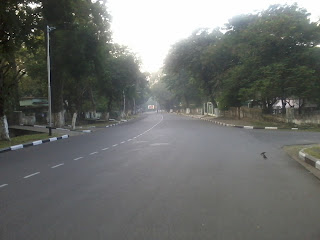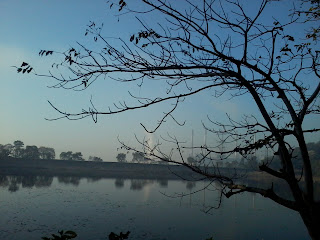"Hey! Kaafi dino baad?! Kya haal-chaal hai?"
"Badhiya hai. Tu bata, kahaan hai aaj kal?"
"Rear me hoon abhi. Aur tu?"
"Gear box"
A rather peculiar conversation, isn't it?
Not quite in Telco Colony, Jamshedpur; given that it predominantly comprises people working for one huge organization, two distant friends from its rear axle shop and gear box shop bumping into each other in a barber shop is commonplace.
Telco Colony
On days when its residents are not paying ostentatious obiesances to Goddess Kali, Goddess
Durga or Babulal Marandi, Telco Colony cuts a most pretty picture: one that is starkly different from a conventional city area. The roads are wide and clean, lined with trees instead of hawkers. The public buildings are all marked by similar boards in one simple font instead of loud, colorful boards and banners. The shops haven't sprouted out in every nook and corner, but they are all clustered together in one area, at walking distances from the residential colonies. The traffic too has a pattern, swelling only at "shift change" hours at the plants, as men and women in uniforms travel to and from work.
 |
| Telco Colony's tree-lined, traffic-free roads |
There are gardens, a most picturesque park, temple, gurudwara, church, mosque and two proper sports stadiums in the colony. The stadiums are packed in the mornings and evenings with kids practicing cricket, boys playing football, and athletes stretching and sprinting.
 |
| Hudco Lake, Moolgaonkar Park, Telco Colony |
 |
| Moolgaonkar Park, Telco Colo |
And then there's Telco Club; with a gym, library, indoor games, restaurant and a bar called 'Paradise', it is truly a place to be for recreation and rest after a hard day at work.
Heart of the City
The most beautiful part of Jamshedpur, however, is its heart: The Iron and Steel Works. Perpetually shrouded in the mist of smoke and vapour spewed out in large plumes by its many chimneys and cooling towers, the gargantuan plant wraps itself in a mythical aura, right at the centre of the city. Visible from several kilometres afar are its towering chimneys, blue and orange hued flames licking furiously at the Jamshedpur
sky at all times.
 |
| Tata Steel Plant |
Birth and Evolution
The city was born with the establishment of an iron and steel making factory, and has evolved with the evolution of industry. Thus, while traditionally, the manufacturing units are pushed to the outskirts of a town or city, things are different in Jamshedpur. Factories are very much a part of the city's landscape, scattered across its length and breadth.
 |
| Just another day at the office |
Rickshaw-wallahs bellow to the people: "Telco!" Telco!" "Tinplate!" "Tinplate!" - and someone inquires "Steel Wire tak jaane ke liye kitna?" referring to Indian Steel and Wire Products unit that falls between Tinplate factory and Tata Motors premises.
Not Rajiv Gandhi
Former prime ministers, politicians and freedom fighters have been relieved of their duties on boards and planks here. Parks, buildings, skill-training institutes and sports stadiums have been named after the chairmen and general managers of TISCO or TELCO, their contribution for long years kept alive in public memory.
 |
| Erstwhile Kalimati Station. Now Tatanagar Junction. |
Sports as a Way of Life
Yet another aspect worth raving about is the awesome sports infrastructure in the city. World-class facilities such as JRD Sports complex, Tata Archery Academy, Tata Football Academy and numerous sports stadiums have led to a thriving sports culture in the city. Further, professional management and industry-sponsored programmes ensure that the best of sporting talent is scouted and nurtured to contribute to Indian sport.
Concluding Thoughts
A row of huts a century ago with the good fortune of close proximity to a railway station (Kalimati station; now Tatanagar Jn), natural water source (confluence of Subarnarekha and Kharkai) and iron ore fields (Mayurbhanj) convinced a group of men of its suitability as most appropriate site for setting up a steel plant. Today, a bustling city has grown around it, and a massive ancillary industry belt nearby.
Since inception, the founders have taken good care of its people, and people returned the embrace, and played an active part in its growth story. In the present day scenario of increasing industry-people conflict, Jamshedpur holds plenty of lessons worth emulating.